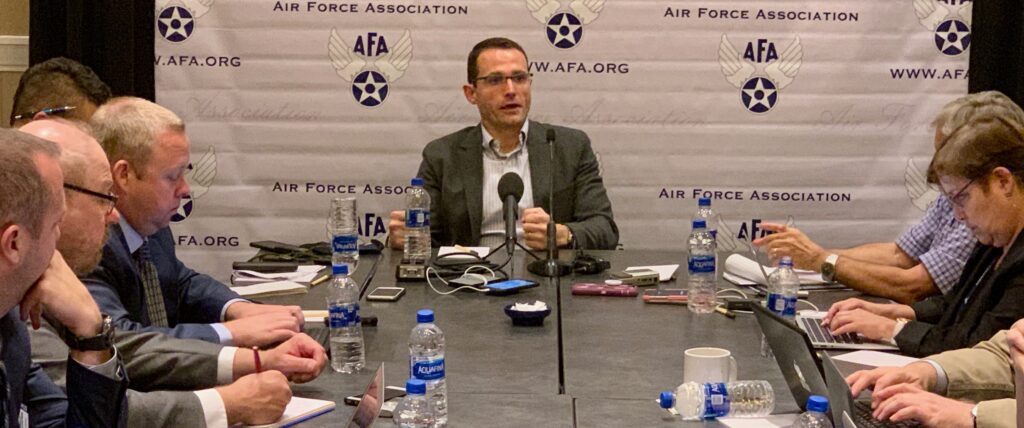
Will Roper takes reporters questions at AFA 2019
AFA 2019: If Air Force acquisition czar Will Roper has his way, “self-flying cars” will be the service’s next far-out acquisition initiative, serving as a broad effort to explore where commercial innovation in the field of flying cars might be a fit for Air Force needs.
Roper said the idea stemmed from discussions by Air Force Special Operations Command with a contractor about a prototype called “Agility Prime,” aimed at replacing the V-22 Osprey. It became clear, he said, that the concept — even if it wasn’t the answer for an Osprey replacement — was a “low-hanging opportunity” to explore the technology writ large.
So, Roper’s office is now working on an acquisition strategy “with a variety of different options to pursue a competition” based on a series of “challenges” — a popular DoD process for tech exploration involving offering “prizes” to winning vendors in order to spur rapid development. The plan is to “kick the program off this fall.”
“We’ve been socializing the idea both over at the White House and inside the department,” Roper said. “I’m using this as a teaching opportunity to get programs pushing technology to not just go traditionally from requirement to end state. The requirements are always well meaning from the warfighters, but we owe it to them to close the loop and bring back opportunities.”
Roper said the idea is to lay out a series of challenges that might involve first a smaller vehicle that could “move a couple of special operators around” all the way up to a heavy-lift system for weapons or supplies.
Roper told the Air Force Association’s annual mega-conference here that he further intends to next apply his “holy trinity” of innovation technology to a satellite development program as a follow-on to the plan to build the Next-Generation Air Dominance (NGAD) fighter using agile software development, open architecture for both hardware and software, and cutting edge “digital engineering.”
“I’m working with Gen. Raymond and SMC on a satellite equivalent, so we can figure out how we become an engineering force, a design force and a production force in the digital world before we ever bend that first piece of metal,” Roper said. He did not elaborate on what program that might be.
Colleague Valerie Insinna of Defense News first reported on how Roper is applying these new development and production processes to the Air Force’s acquisition plan for NGAD. Using these techniques, Roper envisions a “Digital Century Series” of future fighters that are revamped every years to improve performance.
“Digital Century Series is a next-generation capability. It begins as a tech push program seeing how well you can do,” Roper said. Rather than being a replacement for the F-35 per se, Roper explained that it is “a thing beyond the F-35.”
But, he said, “I’m certainly really excited that it provides a low-hanging opportunity to begin exploring what this digital trinity — agile software, open architecture, digital engineering — what they can provide.” He added that he hopes to announce the team for undertaking the NGAD effort in October to “figure out how we do this.”
Roper elaborated on these ideas in his presentation this afternoon.
“Nothing has been as exciting to me as this confluence of agile software, open architecture and digital engineering. Nothing,” Roper told reporters here today. “I’ve stood in the middle of 103 swarming micro-drones, which was awesome. But that’s the point of the spear; its the first thing I’ve seen that looks like a better spear-making machine.”
He explained the newest element of this trinity of technology processes is digital engineering, which uses digital tools to model not just a design but the entire life-cycle of a weapon system, all the way through development, production and sustainment. While there are a number of Air Force efforts attempting to apply agile software development — a term of art that refers to how most commercial software developers work where code is rapidly written, tested by users and released, then rewritten based on feedback — and open architectures that allow third parties to provide updated hardware and software, he said, digital engineering is the capstone that could revolutionize Air Force and DoD acquisition.
“I see something exciting and game changing,” Roper enthused. “When I call it a ‘holy trinity’ I really think it lives up a moniker of that import. … This is a huge thing for the Air Force.”
Major trends and takeaways from the Defense Department’s Unfunded Priority Lists
Mark Cancian and Chris Park of CSIS break down what is in this year’s unfunded priority lists and what they say about the state of the US military.


























